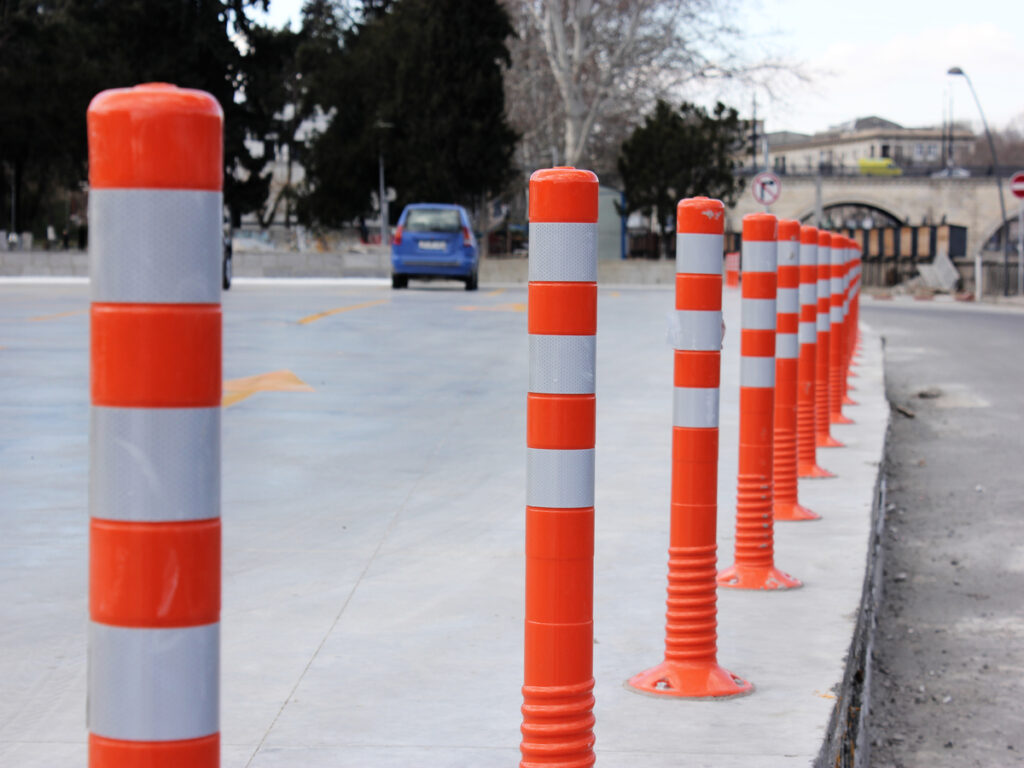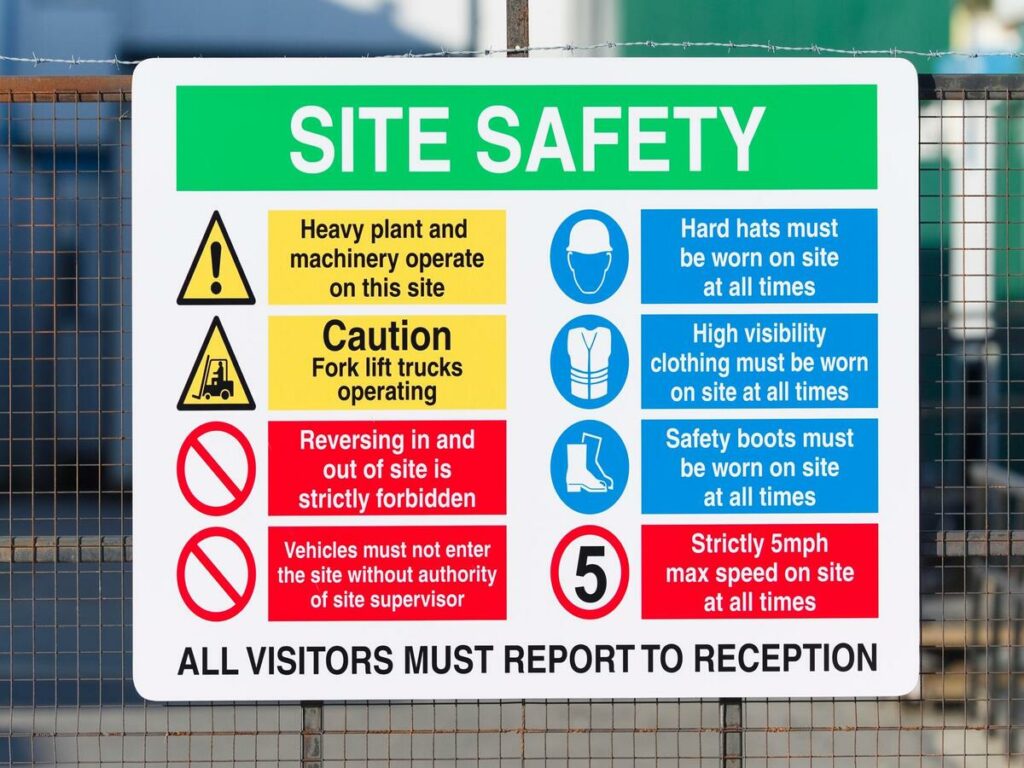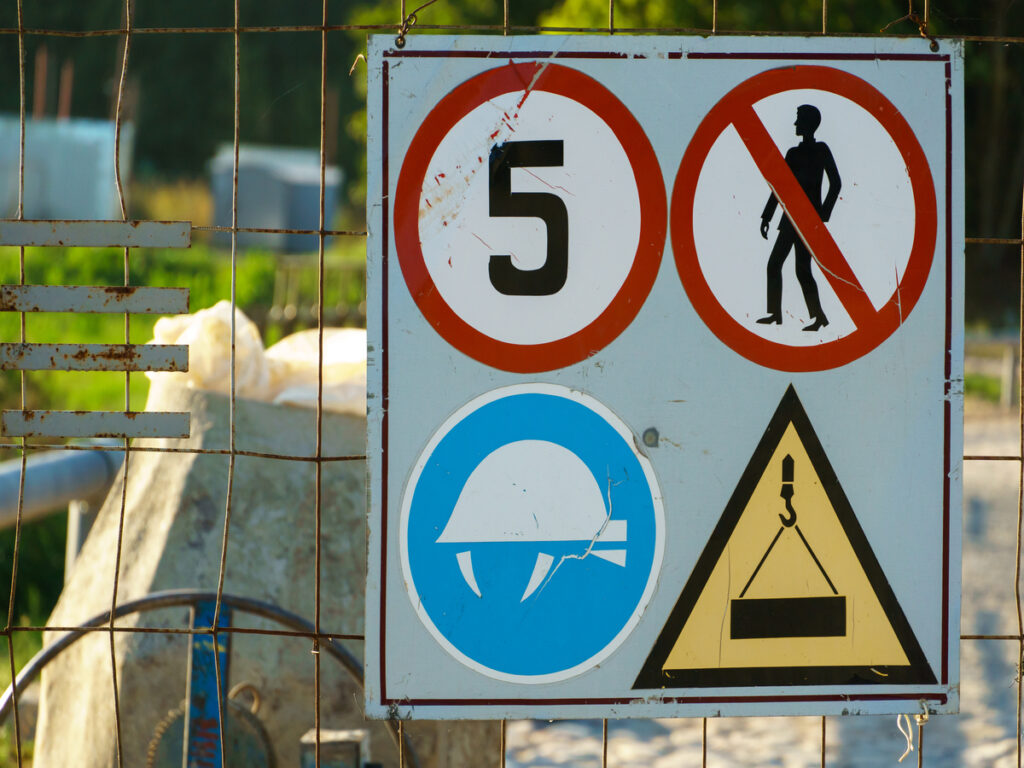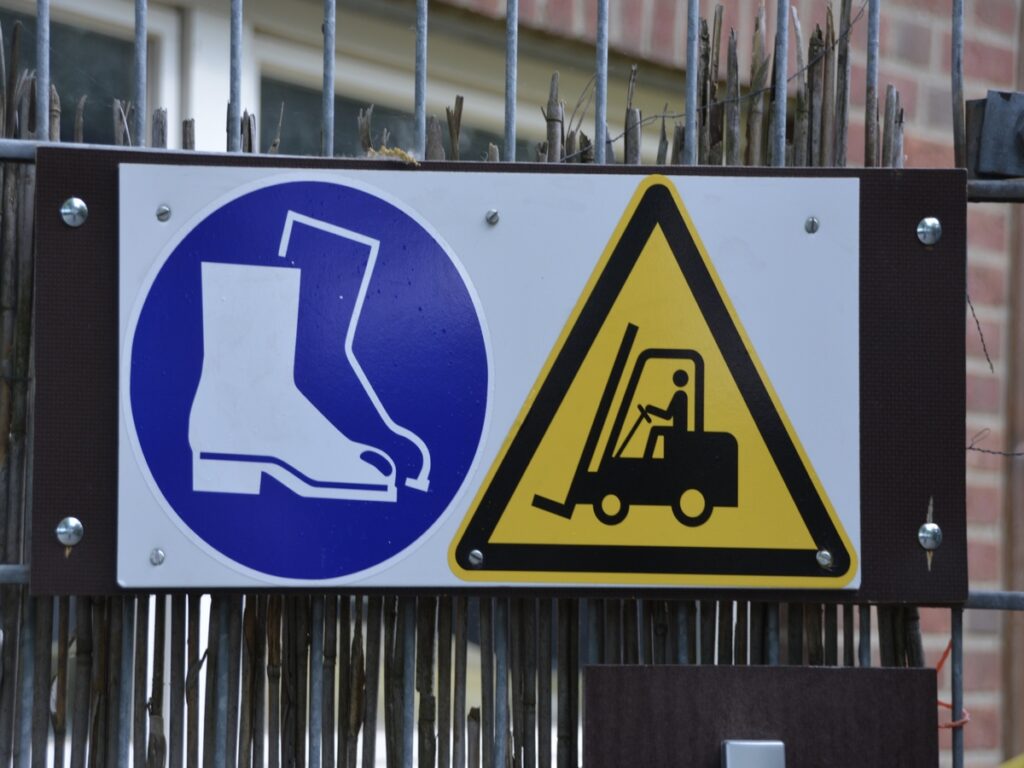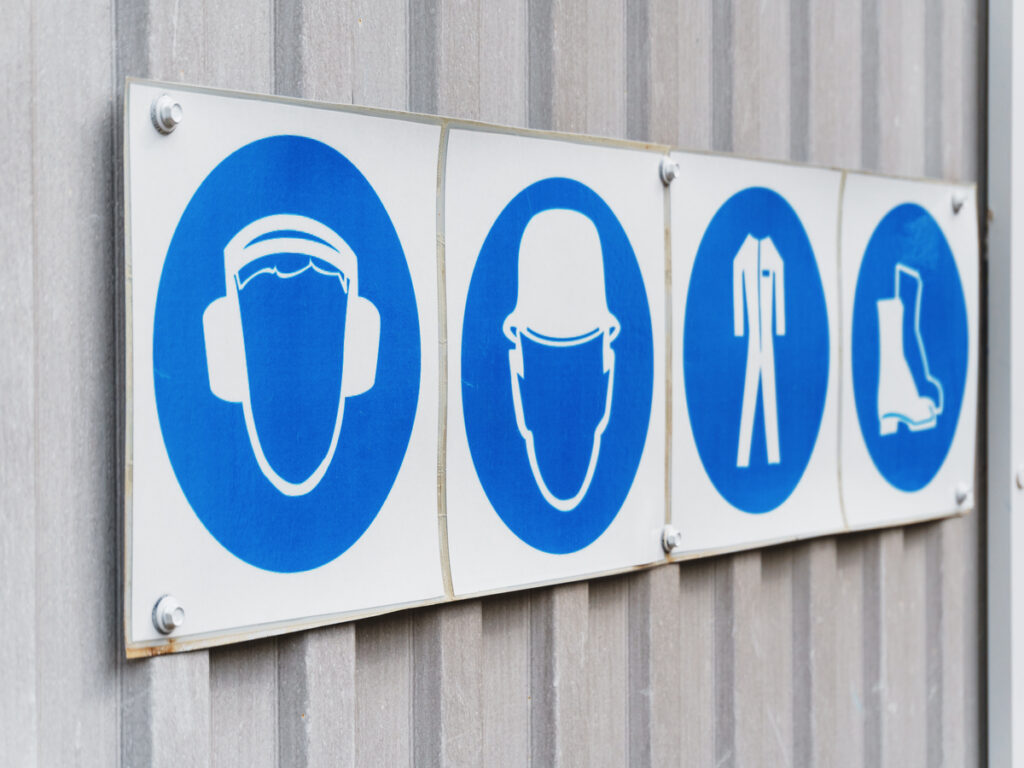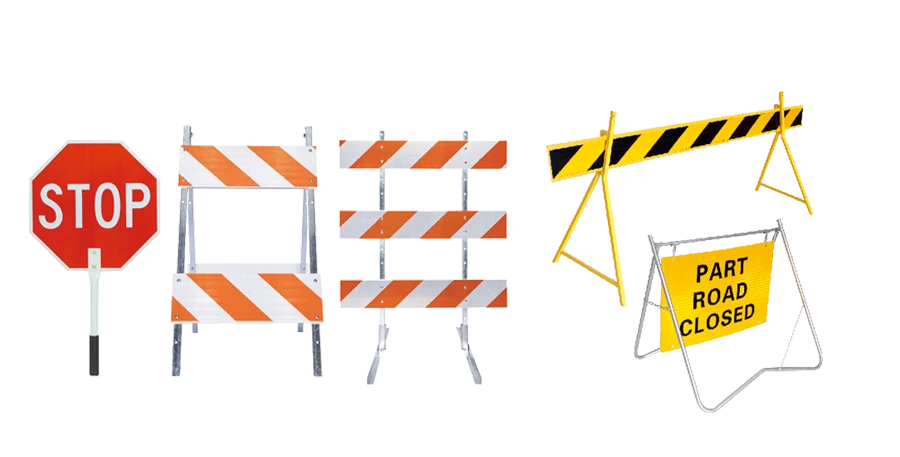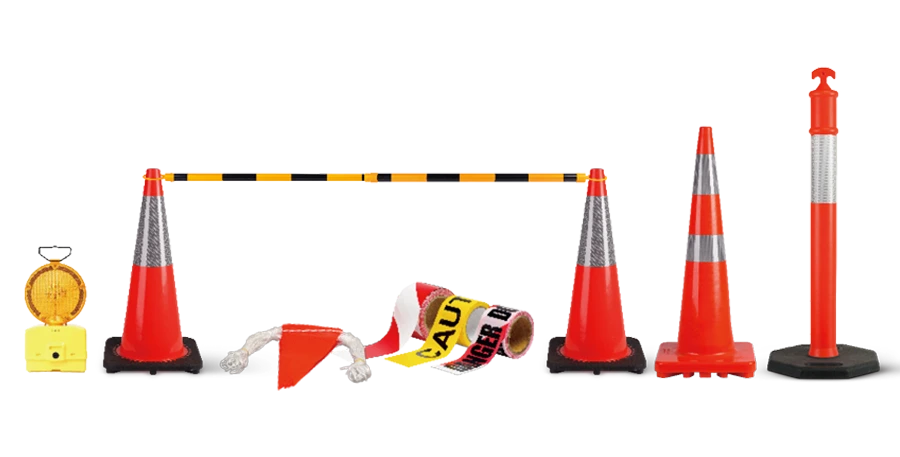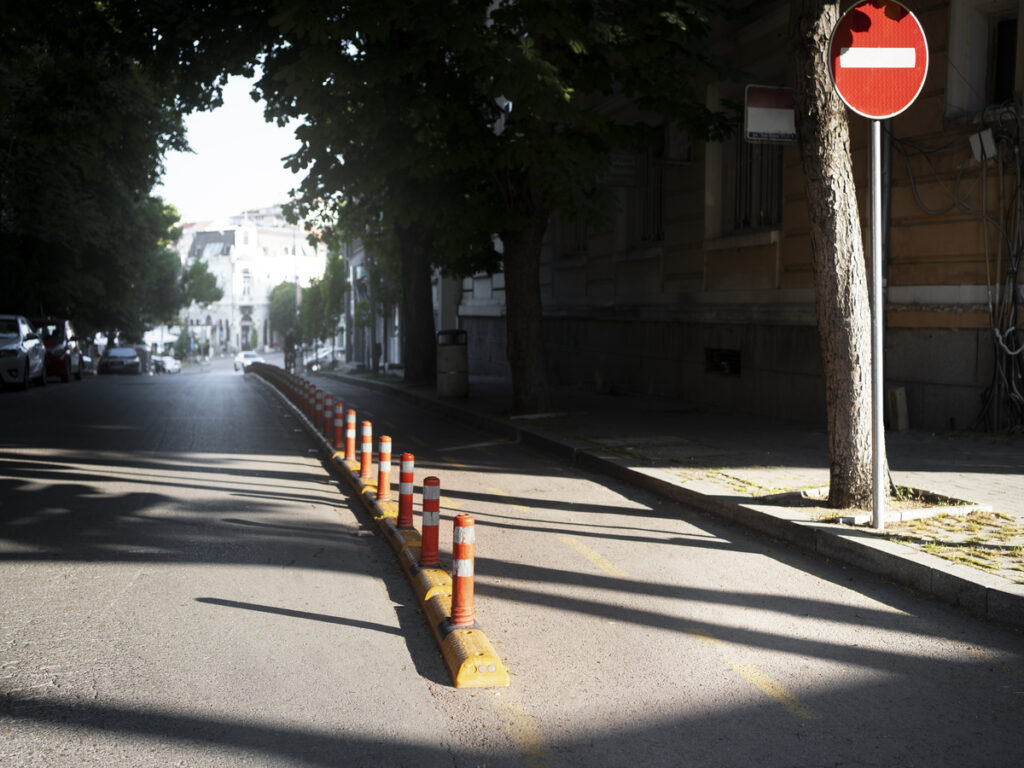
Haben Sie sich jemals gefragt, wie Straßen organisiert und sicher bleiben, Auch im chaotischen Verkehr? Plastik -Delineator spielt eine große Rolle dabei, dies zu erreichen. Diese einfachen und dennoch effektiven Werkzeuge führen Fahrzeuge, Verwirrung verringern, und die allgemeine Sicherheit verbessern. Tatsächlich, Studien zeigen, dass Plastik -Größen gegen die Unfälle bis zu bis hin zu abschneiden können 40%. Sie helfen auch dabei, die Spurdisziplin aufrechtzuerhalten und den Verkehr reibungslos fließen lassen, vor allem in Bereichen mit hohem Risiko.
Die Auswahl des richtigen Materials für eine Plastik -Delineator ist genauso wichtig wie sein Design. Haltbarkeit sorgt dafür, dass es hartes Wetter und Auswirkungen bewältigen kann, Während die Funktionalität die Sichtbarkeit und eine einfache Installation garantiert. Das Ausgleich dieser Faktoren mit Kosten ist der Schlüssel, um den besten Wert für Ihre Investition zu erzielen.
Plastik -Größen verstehen

Was sind Plastikfesteatoren?
Plastik -Größen sind wesentliche Werkzeuge, um Straßen sicher und organisiert zu halten. Sie haben sie wahrscheinlich auf Autobahnen gesehen, Bauzonen, oder Parkplätze, Aber haben Sie jemals darüber nachgedacht, was sie tatsächlich tun? Diese Verkehrsgrößen fungieren als visuelle Führer, Helfen Sie den Fahrern, auf dem richtigen Weg zu bleiben und potenzielle Gefahren zu vermeiden. Sie sind so konzipiert, dass sie die Kanten der Straßen markieren, getrennte Verkehrsspuren, und sogar Fußgängerkreuzungen hervorheben. Auf diese Weise, Sie verringern das Risiko von Unfällen und verbessern den Verkehrsfluss.
Eine der herausragenden Merkmale von Plastikfeinern ist ihre Vielseitigkeit. Sie kommen in verschiedenen Formen, Größen, und Materialien für unterschiedliche Verkehrsmanagementanforderungen entsprechen. Zum Beispiel, Einige sind mit reflektierenden Streifen oder solarbetriebenen Lichtern ausgestattet, um nachts die Sichtbarkeit zu verbessern. Andere werden aus umweltfreundlichen Materialien hergestellt, sie zu einer nachhaltigen Wahl für moderne Verkehrssysteme machen. Egal, ob Sie etwas für ein temporäres Setup oder eine langfristige Lösung benötigen, Es gibt eine Art Delineator, der in die Rechnung passt.
Ein weiterer Grund, warum diese Größen so effektiv sind, ist ihre Benutzerfreundlichkeit. Sie sind leicht, Dies macht Installation und Entfernen zu einem Kinderspiel. Dies ist besonders nützlich für das temporäre Verkehrsmanagement, Wie während des Straßenbaus oder besonderen Veranstaltungen. Plus, Ihre Haltbarkeit sorgt dafür, dass sie heftigen Wetterbedingungen und Auswirkungen standhalten können, sie zu einer zuverlässigen Wahl für Hochverkehrsbereiche machen.
Zusamenfassend, Plastik -Größen sind mehr als nur Straßenmarker. Sie sind ein kritischer Bestandteil der Verkehrssicherheit, Anpassungsoptionen anbieten, um bestimmte Anforderungen zu erfüllen. Durch Führung von Fahrern, Gassen trennen, und Verbesserung der Sichtbarkeit, Sie helfen dabei, sicherere Straßen für alle zu schaffen.
Arten von Kunststoffmaterialien in Verkehrsgrößen
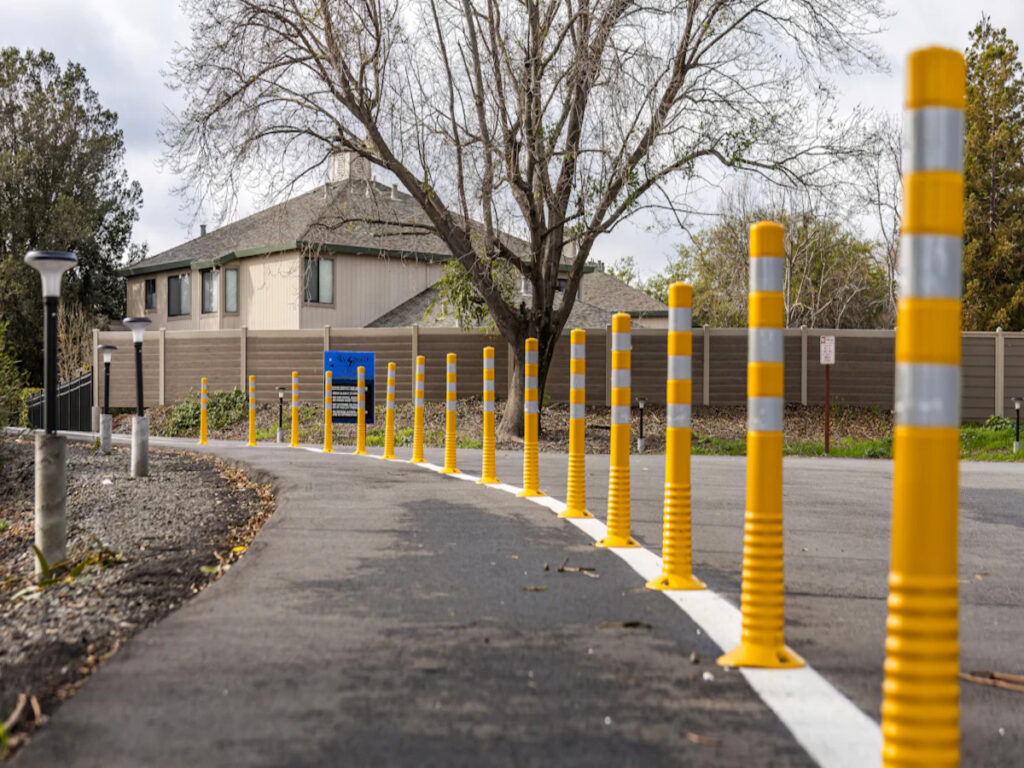
Polyethylen (Pe)
Eigenschaften und Vorteile
Polyethylen, oder, ist eines der beliebtesten Materialien, die bei Verkehrsgrößen verwendet werden. Warum? Es ist leicht, flexibel, und unglaublich langlebig. Sie werden feststellen, dass PE leicht zu handhaben ist, Damit es perfekt für den schnellen Einsatz in geschäftigen Verkehrsbereichen ist. Seine Flexibilität ermöglicht es ihm, sich an verschiedene Straßenbedingungen anzupassen, Während sein Impact -Widerstand sicherstellt. Dies bedeutet weniger Ersatz und niedrigere Wartungskosten für Sie.
Ein weiteres herausragendes Merkmal von PE ist sein UV -Widerstand. Sonneneinstrahlung kann dazu führen, dass einige Materialien im Laufe der Zeit verblassen oder schwächen, aber nicht pe. Es behält seine Sichtbarkeit und strukturelle Integrität bei, Auch im harten Sonnenlicht. Dies macht es zu einer zuverlässigen Wahl für die Verwendung im Freien, vor allem in Bereichen mit intensiven Wetterbedingungen. Plus, Seine wetterresistenten Eigenschaften bedeuten, dass es bei Regen gut abschneidet, Schnee, oder extreme Hitze.
Für eine optimale Lösung, OPTsigns’ Vertikales Panel Und Sicherheitsrommeln, Beide hergestellt aus Premium pe, werden sehr empfohlen. Das vertikale Panel eignet sich perfekt für die Grenzen der Straßengrenzen, Während die Sicherheitstrommeln zusätzliche Sichtbarkeit und Schutz in Bereichen mit hohem Risiko bieten. Bekannt für ihre Haltbarkeit, Wetterwiderstand, und lang anhaltende Leistung, Beide Produkte bieten unter allen Bedingungen zuverlässige Verkehrssicherheit.
Gemeinsame Anwendungen
Sie werden häufig sehen, Wie Bauzonen oder Veranstaltungs Parkplätze. Seine leichte Natur macht es leicht, sich zu bewegen, Das ist ein großes Plus für kurzfristige Projekte. PE ist auch ein Anlaufmaterial für Abläufe in hochvertrieblichen Bereichen, in denen Haltbarkeit und Sichtbarkeit kritisch sind. Egal, ob es Fahrzeuge durch einen Umweg führen oder auf einer belebten Autobahn markieren oder Fahrspuren markieren, PE erledigt den Job.
PE ist auch eine großartige Option für umweltbewusste Projekte. Viele Hersteller produzieren jetzt PE -Größen mit recycelten Materialien, sie zu einer nachhaltigen Wahl für moderne Verkehrssicherheitsausrüstung machen. Wenn Sie nach einem Material suchen, das die Leistung ausgleichen, kosten, und Nachhaltigkeit, PE ist schwer zu schlagen.
Polyurethan (Pu)
Eigenschaften und Vorteile
Polyurethan, oder Pu, ist ein weiteres ausgezeichnetes Material für Verkehrsgrößen. Es ist bekannt für seine Haltbarkeit und Flexibilität, Dies macht es ideal für Bereiche mit starkem Verkehr. Pu Resists und Tränen, Es dauert also länger als viele andere Materialien. Dies bedeutet, Sparen Sie Zeit und Geld.
PU zeichnet sich auch aus der Fähigkeit aus, ihre Form und Funktionalität nach geringfügigen Auswirkungen aufrechtzuerhalten. Ob es sich um ein Auto handelt, das dagegen streift, PU bleibt zuverlässig. Es ist auch sehr beständig gegen Abrieb und Wetterbedingungen, Machen Sie es zu einer Top-Wahl für langfristige Installationen. Wenn Sie etwas brauchen, das mit schwierigen Umgebungen umgehen kann, Pu ist eine fantastische Option.
Für eine zuverlässige Lösung, OPTsigns’ Poly Flex Post, aus hochwertigem Pu hergestellt, wird sehr empfohlen. Entwickelt für Haltbarkeit und Flexibilität, Der Poly Flex Post stand den Aufprall und hartem Wetter stand, Gewährleistung einer konsequenten Leistung im Laufe der Zeit. Perfekt für vorübergehende und dauerhafte Installationen, Dieses Produkt bietet eine verbesserte Sichtbarkeit und Verkehrssicherheit, Machen Sie es zu einer Top -Wahl für anspruchsvolle Umgebungen.
Gemeinsame Anwendungen
Sie finden PU -Größen in Bereichen, in denen Haltbarkeit ein Muss ist, wie Autobahnen oder Industriezonen. Sie sind auch eine beliebte Wahl für dauerhafte Installationen, Dank ihrer langen Lebensdauer und der geringen Wartungsanforderungen. Die Flexibilität von PU macht es für gekrümmte Straßen oder Bereiche mit einzigartigen Verkehrsmustern geeignet. Es ist ein vielseitiges Material, das sich an verschiedene Bedürfnisse anpasst, Gewährleistung der Verkehrssicherheit selbst unter den schwierigsten Bedingungen.
Wenn Sie ein Projekt mit hohem Verkehrsvolumen oder hartem Wetter verwalten, PU -Größen bieten eine hervorragende Leistung und einen hervorragenden Wert. Sie sind eine intelligente Investition für alle, die die Verkehrssicherheit verbessern möchten, ohne die Bank zu brechen.
Ethylen -Vinylacetat (Eva)
Eigenschaften und Vorteile
Ethylen -Vinylacetat, oder Eva, ist ein vielseitiges Material, das häufig in Verkehrsfeierlichkeiten verwendet wird. Es ist bekannt für seine Flexibilität und schockabsorbierende Eigenschaften, die es ideal für Bereiche mit häufiger Fahrzeugkontakt machen. Eva kann sich beugen, ohne zu brechen, Es ist also perfekt für Situationen, in denen Größen gelegentlich Auswirkungen haben könnten. Diese Flexibilität hilft ihm auch, ihre Form im Laufe der Zeit aufrechtzuerhalten, Gewährleistung einer konsequenten Leistung.
Ein weiteres großartiges Merkmal von EVA ist seine leichte Natur. Sie finden es einfach zu handhaben und zu installieren, Dies ist besonders nützlich für temporäre Setups. Eva bietet auch einen hervorragenden Wetterwiderstand. Egal, ob es sengende Hitze oder Kälte ist, Dieses Material hält gut an, Machen Sie es zu einer zuverlässigen Wahl für den Gebrauch im Freien. Plus, Seine Haltbarkeit verringert den Bedarf an häufigen Ersetzungen, Sparen Sie auf lange Sicht Zeit und Geld.
Für verbesserte Sichtbarkeit und Sicherheit, WARNUNGSPOSTS VOLTSIGNS, aus Eva gefertigt, werden sehr empfohlen. Diese Beiträge sind sowohl flexibel als auch langlebig ausgelegt, Sie ideal für hochverkehrsbereite Bereiche, in denen Sicherheit oberste Priorität hat. Mit ihren wetterfesten Eigenschaften und lang anhaltenden Leistung, OPTsigns"EVA -Warnwesen bieten unter allen Bedingungen eine zuverlässige Lösung für die Verkehrssicherheit.
Gemeinsame Anwendungen
EVA ist eine beliebte Wahl für das temporäre Verkehrsmanagement, wie Bauzonen oder Veranstaltungsparkplätze. Das leichte Design erleichtert es einfach, sich nach Bedarf zu bewegen und neu zu positionieren. Sie werden auch sehen, dass EVA in Bereichen verwendet wird, in denen Flexibilität von entscheidender Bedeutung ist, wie gebogene Straßen oder enge Räume. Seine schockabsorbierenden Eigenschaften machen es zu einer sicheren Option für Hochverkehrszonen, Sicherstellung der Verkehrssicherheit auch unter herausfordernden Bedingungen.
Wenn Sie nach einem Material suchen, das Flexibilität kombiniert, Haltbarkeit, und Benutzerfreundlichkeit, Eva ist eine fantastische Option. Dies ist eine praktische Wahl sowohl für kurzfristige als auch für langfristige Anforderungen für die Verkehrssicherheitsausrüstung.
Thermoplastisches Polyurethan (TPU)
Eigenschaften und Vorteile
Thermoplastisches Polyurethan, oder TPU, zeichnet sich als eines der haltbarsten Materialien für Verkehrsgrößen aus. Die einzigartigen Eigenschaften machen es zu einer Top -Wahl für anspruchsvolle Umgebungen. Hier ist eine kurze Aufschlüsselung dessen, was TPU zu Besonderen macht:
| Besonderheit | Beschreibung |
|---|---|
| Haltbarkeit | TPU widersetzt sich, Wetter, und Abrieb, Gewährleistung einer lang anhaltenden Leistung. |
| Flexibilität | Es kann weich und flexibel oder hart und starr sein, Abhängig von Ihren Bedürfnissen. |
| Mechanische Stärke | Bietet ausgezeichnete Kraft, Damit es für verschiedene Verkehrsanwälte geeignet ist. |
| Zähigkeit | TPU widersetzt sich, Gewährleistung der Zuverlässigkeit unter schwierigen Bedingungen. |
| Erholung von Auswirkungen | Es springt nach kleinen Kollisionen zurück, Aufrechterhaltung seiner Form und Funktion. |
| Instandhaltungskosten | Die Haltbarkeit verringert die Wartungskosten, Langzeitwert bieten. |
Die Fähigkeit der TPU, sich von Auswirkungen zu erholen, macht es ideal für Bereiche mit starkem Verkehr. Es funktioniert auch bei extremem Wetter gut, Aufrechterhaltung seiner Sichtbarkeit und strukturellen Integrität. Dieses Material ist eine intelligente Investition, wenn Sie etwas wollen, das anhält.
Für eine fortschrittliche Lösung, Warnposten von Optsigns Hergestellt aus TPU ist eine ausgezeichnete Wahl. Die Option TPU -Warnpost von OptTsigns bietet eine überlegene Haltbarkeit, Schlagfestigkeit, und Flexibilität, Gewährleistung einer lang anhaltenden Leistung in hohen oder gefährlichen Gebieten.
Gemeinsame Anwendungen
Sie werden häufig TPU in dauerhaften Installationen finden, wie Autobahnen oder Industriezonen. Seine Zähigkeit und Flexibilität machen es für hochgeeignete Bereiche geeignet. TPU ist auch eine gute Wahl für Graben bei extremen Wetterbedingungen, Dank seiner Haltbarkeit und des Widerstands gegen das Riss.
Wenn Sie ein Material benötigen, das Stärke kombiniert, Flexibilität, und geringer Wartung, TPU ist schwer zu schlagen. Dies ist eine zuverlässige Option zur Verbesserung der Verkehrssicherheit und zur Gewährleistung einer langfristigen Leistung.
Vergleich von Arten von Abläufern mit Material
Haltbarkeit
Schlagfestigkeit
Wenn es um Aufprallfestigkeit geht, Nicht alle Materialien führen dasselbe durch. Polyurethan fällt auf seine außergewöhnliche Fähigkeit, Verschleiß zu widerstehen, Damit es perfekt für hochwirksame Bereiche wie Autobahnen ist. Polyethylen, auf der anderen Seite, bietet eine anständige Haltbarkeit für mäßige Verkehrsbedingungen. Es ist eine gute Wahl, wenn Sie etwas Leichtes und doch robustes suchen. Gummi ist ein weiterer starker Anwärter. Seine Elastizität ermöglicht es ihm, wiederholte Auswirkungen aufzunehmen, ohne seine Form zu verlieren, Es ist ideal für Bereiche mit häufigem Fahrzeugkontakt.
Leistung bei extremem Wetter
Extremes Wetter kann die Grenzen jedes Materials testen. Polyethylen ist im harten Sonnenlicht aufgrund seines UV -Widerstands gut abgebildet, Sicherstellen, dass es im Laufe der Zeit die Sichtbarkeit beibehält. Polyurethan scheint auch unter schwierigen Bedingungen. Es widersetzt sich und behält seine mechanische Festigkeit bei, Auch bei Gefrierentemperaturen oder sengende Hitze. Gummi, mit seiner hohen Elastizität, behandelt die Temperaturschwankungen effektiv, Machen Sie es zu einer zuverlässigen Option für herausfordernde Umgebungen.
Kosten
Erstinvestition
Die anfänglichen Kosten für Verkehrsgrößen variieren je nach Material. Polyurethan neigt dazu, höhere Voraussetzungen zu haben, Aber seine Haltbarkeit macht es die Investition wert. Polyethylen bietet eine budgetfreundlichere Option, ein Gleichgewicht zwischen Kosten und Leistung treffen. Gummi, während etwas teurer als Polyethylen, bietet einen hervorragenden Wert für Anwendungen, die eine häufige Verformung erfordern.
Langfristige Kosteneffizienz
Wenn Sie langfristig denken, Polyurethan ist eine kluge Wahl. Die Haltbarkeit senkt die Wartungs- und Ersatzkosten im Laufe der Zeit. Polyethylen bietet auch einen guten Wert, insbesondere für temporäre Setups oder mäßige Verkehrsbereiche. Die Fähigkeit von Gummi, wiederholte Auswirkungen zu widerstehen, bedeutet weniger Ersatz, Machen Sie es zu einer kostengünstigen Option für Hochverkehrszonen.
Umweltfaktoren
UV -Widerstand
UV -Widerstand ist entscheidend für die Aufrechterhaltung der Verkehrssicherheit. Polyethylen zeichnet sich in diesem Bereich aus, Beibehalten der Sichtbarkeit auch nach längerer Sonneneinstrahlung. Dies macht es zu einer zuverlässigen Wahl für Verkehrsgrößen im Freien in sonnigen Regionen.
Recyclingabilität und Nachhaltigkeit
Wenn Nachhaltigkeit für Sie wichtig ist, Polyethylen und Gummi sind ausgezeichnete Optionen. Beide Materialien sind recycelbar, Verringerung von Abfällen und Förderung umweltfreundlicher Praktiken. Die Verwendung von recycelten Materialien spart nicht nur Ressourcen wie Erdöl, sondern senkt auch die Kohlenstoffemissionen ein. Viele Hersteller produzieren jetzt Größen aus Post-Consumer- und Industrie-Recycling-Kunststoffen, Stellen Sie sicher, dass sie sich den globalen Bemühungen zum Schutz der Umwelt übereinstimmen.
Installation und Wartung
Einfache Installation
Wenn es um die Installation von Verkehrsfeierlichkeiten geht, Das Material spielt eine große Rolle dabei, wie einfach der Prozess ist. Wenn Sie nach etwas Leichtes und Einfachem zu handhaben sind, Polyethylen (Pe) ist eine fantastische Wahl. Das leichte Gewicht macht den Transport und den Einsatz zu einem Kinderspiel. Sie können schnell PE -Größen einrichten, ohne schwere Geräte oder ein großes Team zu benötigen. Aus diesem Grund ist PE für temporäre Setups wie Bauzonen oder Veranstaltungsparkplätze so beliebt.
Polyurethan (Pu), auf der anderen Seite, ist bekannt für seine Haltbarkeit und Flexibilität. Während es sich in langfristiger Leistung hervorhebt, Es bietet nicht das gleiche Maß an Leichtigkeit während der Installation wie PE. Wenn Ihr Projekt die schnelle Bereitstellung priorisiert, PE könnte die bessere Option sein. Jedoch, Wenn Sie sich auf die Haltbarkeit für dauerhafte Installationen konzentrieren, PU ist es wert.
Wartungsanforderungen
Die Wartung ist ein weiterer kritischer Faktor, über den Sie bei der Auswahl der Größen nachdenken sollten. Thermoplastisches Polyurethan (TPU) fällt hier hin. Seine Haltbarkeit und Flexibilität machen es zu einer wartungsarmen Option. TPU widersetzt sich, Wetter, und Abrieb, Es hält sich in Bereichen mit hohem Aufprall gut an. Sie müssen es nicht oft ersetzen, Das spart Ihnen auf lange Sicht Zeit und Geld. Seine mechanische Stärke stellt sicher, dass sie seine Form und Funktionalität im Laufe der Zeit aufrechterhalten, Auch unter schwierigen Bedingungen.
Wenn Sie ein Projekt in einem Bereich mit hohem Verkehr verwalten, TPU ist eine kluge Wahl. Seine Widerstandsfähigkeit bedeutet weniger Ersatz und geringere Wartungskosten, Machen Sie es zu einer zuverlässigen Option zur Verbesserung der Verkehrssicherheit. Unabhängig davon, TPU liefert eine konsequente Leistung mit minimaler Unterhalt.
Vor- und Nachteile von Kunststoff -Delineator -Materialien
Polyethylen (Pe)
Vorteile
Polyethylen ist für viele ein Favorit, wenn es um Verkehrsgrößen geht. Warum? Es ist leicht, Es ist super einfach zu transportieren und zu installieren. Sie können es schnell einrichten, ohne schwere Ausrüstung oder eine große Besatzung zu benötigen. Seine Flexibilität hilft ihm auch, kleinere Auswirkungen ohne Brechen umzugehen, Das eignet sich hervorragend für Gebiete mit mäßigem Verkehr. Plus, Es ist UV-resistent, Es wird also unter der Sonne nicht verblassen oder schwächen. Dies macht es zu einer zuverlässigen Wahl für die Verwendung im Freien. Wenn Sie nach etwas kostengünstig und Langlebig suchen, PE überprüft alle Kästchen.
Nachteile
Während PE langlebig ist, Dies ist nicht die beste Option für Bereiche mit starkem Verkehr oder häufigen Auswirkungen. Es hält möglicherweise nicht so gut wie andere Materialien in Hochstressumgebungen. Auch, seine leichte Natur, zwar bequem, kann es unter windigen Bedingungen weniger stabil machen. Wenn Sie für langfristig etwas brauchen, Nutzung mit hoher Auswirkung, Vielleicht möchten Sie andere Optionen erkunden.
Polyurethan (Pu)
Vorteile
Polyurethan ist ein Kraftpaket, wenn es um Haltbarkeit geht. Es kann mit starkem Verkehr und hartem Wetter umgehen, ohne ins Schwitzen zu bringen. Seine Flexibilität ermöglicht es, nach geringfügigen Auswirkungen zurückzuspringen, Aufrechterhaltung seiner Form und Funktionalität. Dies macht es perfekt für dauerhafte Installationen in Hochverkehrszonen. PU widersetzt sich auch Verschleiß und Tränen, Sie müssen es also nicht oft ersetzen. Wenn Sie eine langfristige Verkehrssicherheit anstreben, Pu ist eine solide Wahl.
Nachteile
Die Haltbarkeit von PU ist mit einem etwas höheren Preis verbunden. Die anfängliche Investition kann sich steil anfühlen, Vor allem, wenn Sie an einem knappen Budget arbeiten. Es ist auch etwas schwerer als PE, Dies kann die Installation etwas arbeitsintensiver machen. Jedoch, Die lange Lebensdauer fällt diesen Nachteilen oft aus, Es lohnt sich, für anspruchsvolle Projekte nachzudenken.
Acryl
Vorteile
Acrylsticht auf seine Klarheit und Sichtbarkeit hervorgehoben. Es wird oft in Größen verwendet, die Aufmerksamkeit auf sich ziehen müssen, insbesondere bei schlechten Lichtverhältnissen. Die glatte Oberfläche macht es einfach zu reinigen, Es bleibt also länger neu aussehen. Acryl ist auch gegen UV -Strahlen resistent, Stellen Sie sicher, dass es im Laufe der Zeit nicht gelb oder verschlechtert sich nicht. Wenn Sichtbarkeit und Ästhetik Ihre obersten Prioritäten haben, Acryl ist eine fantastische Option.
Nachteile
Acryl ist nicht so flexibel wie PE oder PU. Bei starken Stößen ist es anfälliger für Risse, was den Einsatz in stark frequentierten oder stark beanspruchten Bereichen einschränkt. Außerdem ist es bei extremen Wetterbedingungen weniger haltbar, Daher ist es möglicherweise nicht die beste Wahl für Außeninstallationen in anspruchsvollen Umgebungen. Während es sich durch seine Sichtbarkeit auszeichnet, Es ist nicht das robusteste Material für Hochleistungsanwendungen.
Ethylen -Vinylacetat (Eva)
Vorteile
EVA ist ein herausragendes Material für Verkehrsleitschilder, dank seiner einzigartigen Eigenschaften. Seine Flexibilität ist eine seiner größten Stärken. EVA lässt sich leicht biegen, ohne zu brechen, Damit eignet es sich perfekt für Bereiche, in denen Fahrzeuge gelegentlich gegen die Leitpfosten stoßen könnten. Diese Flexibilität sorgt auch dafür, dass das Material seine Form im Laufe der Zeit behält, Sie müssen sich also keine Gedanken über ständigen Austausch machen.
Ein weiterer toller Vorteil von EVA ist sein geringes Gewicht. Sie finden es einfach zu handhaben und zu installieren, Dies ist besonders hilfreich für temporäre Einrichtungen wie Baustellen oder Veranstaltungsparkplätze. EVA funktioniert auch bei verschiedenen Wetterbedingungen gut. Ob es glühend heiß oder eiskalt ist, Dieses Material bleibt zuverlässig. Aufgrund seiner Langlebigkeit ist weniger Austausch erforderlich, Sparen Sie sowohl Zeit als auch Geld.
Nachteile
Während EVA viele Vorteile hat, es ist nicht ohne Einschränkungen. Sein leichtes Design, zwar bequem, kann es unter windigen Bedingungen weniger stabil machen. Dies ist möglicherweise nicht ideal für Gebiete mit starken Böen. EVA bietet außerdem nicht die gleiche Schlagfestigkeit wie einige andere Materialien wie TPU. Wenn Sie mit starkem Verkehr oder stark belasteten Zonen zu tun haben, EVA ist möglicherweise nicht die beste Wahl.
Thermoplastisches Polyurethan (TPU)
Vorteile
TPU ist ein Kraftpaket, wenn es um Haltbarkeit und Flexibilität geht. Es ist verschleißfest, Wetter, und Abrieb, Machen Sie es zu einer Top-Wahl für langfristige Installationen. TPU bietet außerdem eine hervorragende mechanische Festigkeit und Zähigkeit, So hält es auch in stark frequentierten Bereichen gut stand. Seine Fähigkeit, sich von geringfügigen Auswirkungen zu erholen.
Ein weiterer Vorteil von TPU ist seine Vielseitigkeit. Sie können es für verschiedene Umgebungen anpassen, Ob Sie etwas Weiches und Flexibles oder Hartes und Starres brauchen. Diese Anpassungsfähigkeit macht es zu einer zuverlässigen Option, die Verkehrssicherheit unter verschiedenen Bedingungen zu verbessern. Plus, Die Haltbarkeit senkt die Wartungskosten, Ihnen einen langfristigen Wert geben.
Hier finden Sie eine kurze Aufschlüsselung der Vor- und Nachteile der TPU:
| Vorteile von TPU | Nachteile von TPU |
|---|---|
| Langlebig und flexibel | Weniger elastisch als Gummi |
| Widersetzt sich, Wetter, und Abrieb | Kann unter wiederholter Verformung nicht gut abschneiden |
| Ausgezeichnete mechanische Stärke | |
| Für verschiedene Umgebungen anpassbar | |
| Zähigkeit und Widerstand gegen das Knacken | |
| Reduziert die Wartungskosten |
Nachteile
Trotz seiner vielen Stärken, TPU ist nicht perfekt. Es ist weniger elastisch als Gummi, Dies bedeutet, dass es unter wiederholter Verformung möglicherweise nicht so gut funktioniert. Während TPU in der Haltbarkeit hervorragende Leistungen erbringt, Es ist möglicherweise nicht die beste Wahl für Anwendungen, die häufiges Biegen oder Dehnen erforderlich sind. Jedoch, Für die meisten Verkehrssicherheitsbedürfnisse, Seine Vorteile überwiegen bei weitem diese kleinen Nachteile.
Die Auswahl des richtigen Materials für Verkehrsgrößen hängt von Ihren spezifischen Anforderungen ab. Jedes Material hat seine Stärken:
- Polyethylen: Leicht, flexibel, und UV-resistent. Es ist erschwinglich und toll für temporäre Setups, aber weniger langlebig für starken Verkehr.
- Polyurethan: Extrem langlebig und ideal für hochwertige Bereiche. Während es im Voraus mehr kostet, Es bietet einen langfristigen Wert.
- Gummi: Ausgezeichnete Elastizität und Stoßdämpfung. Perfekt für dynamische Umgebungen, aber weniger abriebfest als Polyurethan.
Bei der Entscheidung, Betrachten Sie diese Faktoren:
- Haltbarkeit: Wesentlich für starken Verkehr oder hartes Wetter.
- Funktionalität: Materialien sollten die Sichtbarkeit verbessern und einfach zu installieren sein.
- Kosten: Gleichgewicht der Anfangskosten mit langfristiger Leistung.
Für starken Verkehrsbereiche, Polyurethan oder Gummi funktioniert am besten. Für temporäre Installationen, Polyethylen bietet eine budgetfreundliche Option. Durch die Übereinstimmung mit dem Material mit den Anforderungen Ihres Projekts, Sie sorgen für Sicherheit und Effizienz auf der Straße.
FAQ
Woraus ist eine Plastik -Delineatorin?
Eine Plastikdelineator wird aus Materialien wie Polyethylen hergestellt (Pe), Polyurethan (Pu), Acryl, Eva, oder TPU. Jedes Material bietet einzigartige Vorteile, wie Flexibilität, Haltbarkeit, oder UV -Widerstand. Die Auswahl hängt von Ihren spezifischen Verkehrs -Plastik -Delineator -Bedürfnissen ab.
Wie wähle ich das richtige Material für meine Plastik -Delineator aus?
Betrachten Sie drei Schlüsselfaktoren:
- Haltbarkeit: Für starken Verkehr, Gehen Sie mit PU oder TPU.
- Kosten: PE ist budgetfreundlich für temporäre Setups.
- Umfeld: Suchen Sie nach UV-resistenten oder recycelbaren Optionen, wenn Nachhaltigkeit wichtig ist.
Kann ein Plastik -Delineator extremes Wetter greifen??
Ja! Materialien wie PE und TPU funktionieren unter harten Bedingungen gut. Pe widersetzt sich UV -Strahlen, während TPU in extremer Hitze oder Kälte stark bleibt. Diese Funktionen machen sie für den Gebrauch im Freien zuverlässig.
Sind Plastikfeinatoren einfach zu installieren?
Absolut! Leichte Materialien wie PE und EVA machen die Installation schnell und problemlos. Sie können sie ohne schwere Ausrüstung einrichten, Zeit und Mühe sparen. TPU, während schwerer, bietet eine langfristige Haltbarkeit für dauerhafte Setups.
Sind Plastikfeste umweltfreundlich?
Viele Größen verwenden recycelbare Materialien wie PE oder EVA. Einige Hersteller produzieren sie sogar aus recycelten Kunststoffen, Verringerung von Abfall und Förderung von Nachhaltigkeit. Wenn Umweltfreundlichkeit Priorität hat, Suchen Sie nach diesen Optionen.

